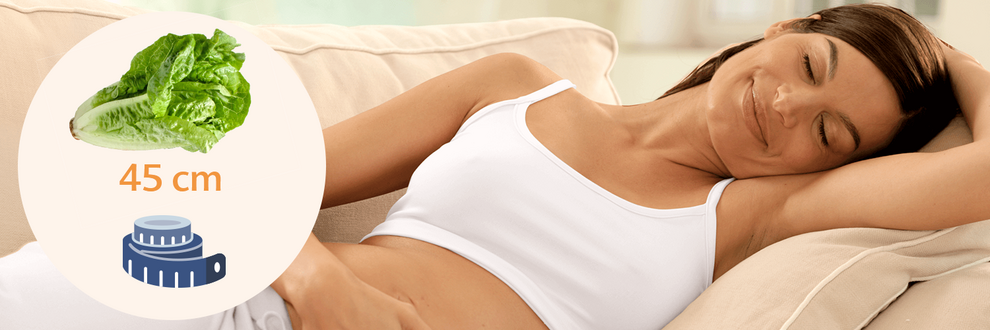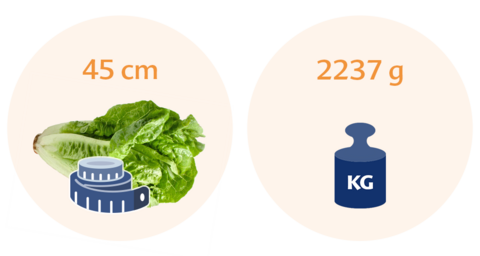Pregnancy weeks:
Week 34 of pregnancy: Indulge yourself and enjoy the last few weeks of your pregnancy

Size of your baby in week 34

Your baby, who will see the light of day in a few weeks’ time, is now around 45 cm long – the size of a large romaine lettuce. They’re putting on weight faster and faster and now weigh 2237 grams, so they’ll soon be at their birth weight. Don’t worry if your baby doesn’t appear to be growing as much as they should or putting on the right amount of weight: this will vary from baby to baby and is hugely influenced by their genes.
Your baby’s development
Your baby’s senses are now at an advanced stage of development, and their hearing improves in particular in week 34. They can hear high-pitched sounds very well at this stage and, once they’re out of the womb, they’ll recognise the sound of the music and voices they’re now hearing. This familiarity will increase their sense of trust and calm them down when they’re a newborn.
Their skeletal system is absorbing all the calcium it can get to make their bones more dense, which in turn will make them harder, stronger and more robust. However, their bones won’t be fully developed by the time they’re born, so it’s a good idea to give them additional vitamin D. You can get a prescription from your paediatrician at the paediatric health screening, and the latest recommendations are that all newborn babies should get vitamin D every day in the form of drops or tablets until they’ve lived through two springs.
Meanwhile, their lungs are still in the final stages of development so that they become more robust and reliable.
With less and less space in the womb to move around freely, your baby will be turning from one side to the other with their whole body. If you’re expecting twins, this lack of freedom for them will be even more of a problem and their movements will feel even more intense because of the restricted space. Twins also make ultrasound scans more challenging: they tend to lie on top of each other, which makes it harder for doctors to find and display their two heartbeats accurately.
In week 34, a baby boy’s testicles will move down from their abdomen to their scrotum. An ultrasound will show that the scrotum looks very big at this stage, which is caused by the water it retains. Lots of baby boys still have a large, swollen-looking scrotum when they’re born: it’s nothing to worry about, and it will assume its normal size after a few days.
Your baby will receive a stimulus which encourages them to move gradually into the right position for a normal, natural birth.
Your baby will move into their final position for birth around four weeks in advance. Some babies stay in the embryonic squat position with their legs drawn up for a very long time and only turn around when labour begins.
What it’s like for the mum-to-be in week 34
As your baby grows bigger, it is normal to feel worried and anxious about childbirth especially of the pain and the delivery process. It is important to have a positive outlook, be relaxed and stay cheerful, so that you do not give yourself undue stress.
If you have any uncertainty or worries that keep bothering you, you can check with your doctor, attend antenatal classes or chat with other parents and new mums-to-be. These avenues of support will prepare you for the process.
Do not bottle up your feelings. You need to talk to someone to get support. Set priorities so that you do not get overloaded with too many things at the last minute.
Common signs and symptoms
Back pain and shortness of breath are the main symptoms experienced by pregnant women in week 34. In around two weeks, your false labour will begin, which will move your womb together with your baby further down towards your lesser pelvis. This process can cause other symptoms such as diarrhoea and slight nausea, but they’ll soon disappear.
Downward pressure
You may have noticed an unusual sensation of downward pressure. This is caused by the weight of your baby pushing down on your pelvic floor, and it can increase after false labour as your baby moves towards your lesser pelvis. You can alleviate this yourself by doing some gentle exercises, such as rocking from side to side while sitting down. This will relax your pelvic ring and the surrounding tissue, preventing tension in this area.
False labour or actual labour?
You should pack your bag for birth and have it ready in a safe place before false labour begins, as many parents-to-be aren’t sure if it’s false labour or actual labour. First-time parents in particular very often head straight to the hospital, only to be sent back home when it turns out to be a “false alarm”. Don’t worry too much if that’s the case – in fact, it’s excellent practice for the big day when real labour begins and you give birth.
Questions you may want to ask your doctor
Perineal tear/incision (episiotomy)
To minimise the risks of a perineal tear or the doctor having to make a perineal incision during childbirth, you can massage your perineum daily in a circular motion with a high-quality oil or special perineal massage oil during the final weeks of pregnancy. This relaxes the tissue, making it softer and more flexible so that it gives way more easily when your baby’s head comes through.
What if my baby doesn’t want to turn?
It can be enough to change your position and gently lift your hips up and down. This will make it a bit uncomfortable for your baby and they might turn around.
Light can also cause your baby to turn around. To try it, you need to be in a dark environment – e.g. under a blanket. Then take a flashlight and point it at the bottom of your belly. Your child will see the light and might turn towards it.
Another method suggests using sound to turn the baby. Take a small bell or a Baoding ball and tie it to your waistband so that it can ring whenever you move. Your baby will take interest in finding the origin of these sounds, possibly causing your baby to turn around.
All of these methods have helped expectant mothers to get their baby from a breech position into the right birth position. Your doctor will certainly have more tips and tricks to help you change your baby’s position and prevent a more complicated birth or a C-section.



